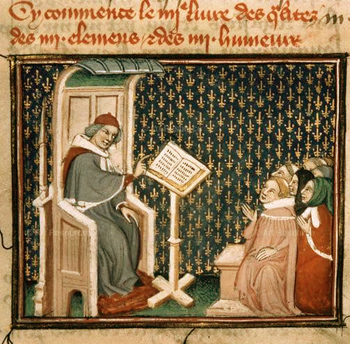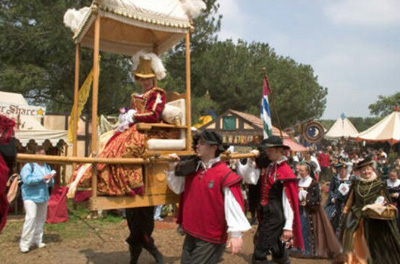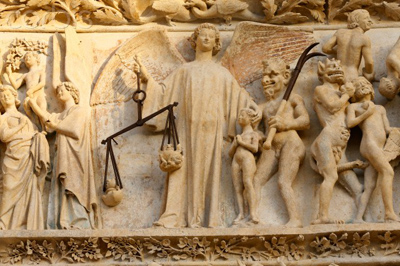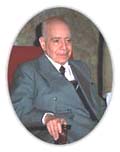Organic Society
 |
 |
 |
 |
 |
 |
 |
The Social Classes - V
Intellectual Class, City & Country Workers
Besides the Clergy and the Nobility, in the Middle Ages there was another class which, according to the natural order, had a strong influence on society: the class composed of intellectuals. This is because ideas are what direct men in life.
Even when someone says: “My interests are what direct me,” it is the idea he made of the importance of his interests that is actually directing him. He constructed a system of ideas, his own philosophy of life, in order to deny the importance of ideas. Without ideas, man cannot go ahead. It is ideas that direct men in life.
 The class of university professors – which was the class of thinkers – had great influence in the Middle Ages. The intellectual conceived his doctrines in the calm refuge of the university, but he enjoyed an enormous prestige in society, a glory difficult for a modern man to comprehend.
The class of university professors – which was the class of thinkers – had great influence in the Middle Ages. The intellectual conceived his doctrines in the calm refuge of the university, but he enjoyed an enormous prestige in society, a glory difficult for a modern man to comprehend.
When a medieval professor delivered a series of excellent lectures, he would become famous in the region and students from many cities would come to hear his classes. When he would give a truly outstanding class, his students would wait for him outside the university confines and throw their capes on the street for him to walk on them. Sometimes this homage would continue until the professor reached his house, normally not a far distance from the university.
Other times, as a form of homage for an exceptional presentation, the students would carry the professors on a litter or sedan chair - a chair borne on poles by two bearers - from the university to his house. Along the way they would discuss the class topic with him. So, a man walking through those narrow medieval streets would suddenly be stopped by a large, noisy group of students carrying their professor, gravely sitting on a sedan chair. It was Master Gottfried, who had a cathedra in this or that subject, who had finished giving a stupendous class. His fame would radiate through the neighboring cities.
This scene helps us to understand the importance of academics in civil life. When a thesis defense would take place, it was frequent for the court of the local noble to move to the city to watch it.
 When there was a dispute between two famous doctors, even the King and Queen would travel to be present at that event. Places would be arranged for the King, Queen, the High Clergy and Nobility, the Rector and dignitaries of the university and the two professors at their individual lecterns so that they could debate the topic and be heard by all present. This discussion of ideas was an important event in the social life of all these people. It was a discussion of ideas. This helps to understand the eminent respect the medieval man had for ideas.
When there was a dispute between two famous doctors, even the King and Queen would travel to be present at that event. Places would be arranged for the King, Queen, the High Clergy and Nobility, the Rector and dignitaries of the university and the two professors at their individual lecterns so that they could debate the topic and be heard by all present. This discussion of ideas was an important event in the social life of all these people. It was a discussion of ideas. This helps to understand the eminent respect the medieval man had for ideas.
The events of medieval public life were impregnated with ideas. Political acts, for example, were backed by a series of theories. The politician, taught by the great masters of the university, meditated a great deal on what he had learned. For this reason, political actions were consistent with the doctrines taught by the Church and expanded on in the lectures at the universities. In politics, administration, economy, family life - in every human sphere - the theories discussed in the universities had an important function.
One of the beautiful aspects of the Middle Ages is that we find a grand ensemble of theories, harmonic and coherent among themselves, taught by the Church councils, theologians and doctors at the universities. This ensemble influenced the whole temporal sphere, from the organization of the State to each cell of society - military life, family life, etc.
Thus, the direction of the Middle Ages was shared by a threefold elite:
In that society protected by this threefold elite, what was the situation of the man of the people?
The man of the people was not anonymous, as he is today. Among the people there were also natural elites. Each craft and profession had its own guild with a hierarchy, divided into master, companion and apprentice. When the worker achieved a certain expertise in his profession, he would ask to be examined by a group of senior workers.
 If they would approve him, he would pass from apprentice to companion. When he reached a certain point of excellence in his work, he would apply to be received as a master. If he qualified, then the guild would officially grant him the title of master, which implied many responsibilities and some privileges.
If they would approve him, he would pass from apprentice to companion. When he reached a certain point of excellence in his work, he would apply to be received as a master. If he qualified, then the guild would officially grant him the title of master, which implied many responsibilities and some privileges.
Some of the guilds would require a man to execute a masterpiece, a work of art displaying his skill in that profession, to become master. So, if the guild were one of saddle makers, then, the potential master would need to invent a new improvement for the saddle that would make his work unique. The examination would be made by saddle maker masters from different regions, who would gather together for the occasion.
Thus, on a smaller scale, we see that to become a master a man had do defend an achievement in the branch of his craft just like a professor had to defend a thesis to become a doctor. Those masters were authorities in their own milieu and received honor, distinction and respect.
Much of the life of the people in cities was regulated by the lives of their respective guilds. A smaller part of the population that was not part of the professional guilds would work as employees of the wealthy bourgeois, cooking and cleaning for them, helping them care for their children, properties, horses, etc.
The countryside worker
In the fields there were the peasants who, by the simple fact they lived in the countryside, did not belong to the city guilds. They were workers of the land. Under the feudal system, the Lord had a contract with each peasant similar to the one he had with the King. That is, he would give the peasant a parcel of land sufficient for him to live on, cultivate and provide for his family.
As a part of the contract, the peasant was obliged to give a small part of that production to the Lord and to work an established number of hours a week in the fields of the Lord. This system was so fair that most of those peasants had more than necessary for their own use and sold their surplus goods at the local farmers’ markets. The public fairs were born in good part from the surplus of the peasants’ production.
The Church’s teaching dignified poverty
Nonetheless, their lives were modest and humble. But the man of the people lived his humble life protected and enlightened by the Church. The Church taught all classes that the important thing in life is not to be rich or poor, noble or plebeian, but rather to have a true and integral Catholic Faith. What was important was to be honest, pure and loyal in each one’s state of life.
She preached that a man could suffer on earth every misery and that he could turn those sufferings to his benefit if he bore them in conformance with the Commandments. She taught that when a man dies - be he noble or plebeian, intellectual or illiterate - he would be judged according to a just criterion by an impartial and severe Judge, who would reward or punish each one according to good or evil he had practiced, and not according to the social class to which he had belonged.
 This conviction inspired the life of all, particularly of the man of the people, who had a humbler position in that society. He knew that when Jesus Christ was on earth, He practiced the modest profession of carpenter. The idea that Our Lord Himself had chosen to be poor conferred a great dignity to poverty and even to mendicancy. This religious halo of virtue around poverty explains why Kings would wash the feet of lepers, serve the poor, and often declare that, if they could, they would abandon their regal lives to become one of the poor of Christ.
This conviction inspired the life of all, particularly of the man of the people, who had a humbler position in that society. He knew that when Jesus Christ was on earth, He practiced the modest profession of carpenter. The idea that Our Lord Himself had chosen to be poor conferred a great dignity to poverty and even to mendicancy. This religious halo of virtue around poverty explains why Kings would wash the feet of lepers, serve the poor, and often declare that, if they could, they would abandon their regal lives to become one of the poor of Christ.
Final Judgment, Heaven and Hell were represented in the Middle Ages everywhere. Not only in the art of churches, but in the carving of furniture and objects of decor for houses - everywhere. One could often find depictions of just men who die with their souls being carried off to Heaven by Angels, as well as scenes of bad men whose souls were being dragged to Hell by devils.
Life in the Middle Ages was fully explained and understood from the perspective of the Final Judgment. This life passes; it is nothing but a preparation for a more important eternal life. A man’s value lay in the merit of the virtues he practiced. This great axiom was the dominant element of social life.
Thus, we find ourselves in a world where everything was established under the light of principles, a world completely different from today’s society. The goal was not to embark on a frenzied career to earn money and enjoy life. The goal was to live in order to win Heaven, to serve and fulfill the designs of Divine Providence for each man on earth. If a man were to accomplish this, then he would be a blessed in his own class and state of life.
With this we reach the end of this series.
Having analyzed how the medieval epoch conceived society and arranged its social life, we put together many Catholic elements about organizing the temporal sphere. It provides a rich inspiration on how to resolve contemporary problems.
In the begining of this series, we had seen Pius XII inviting Catholics to enter the discussion on how the direction of a State should be participated in order to have harmony among the classes. The principles that inspired the wise distribution of functions in the Middle Ages may well serve as a contribution toward this end.

Posted August 12, 2013
Even when someone says: “My interests are what direct me,” it is the idea he made of the importance of his interests that is actually directing him. He constructed a system of ideas, his own philosophy of life, in order to deny the importance of ideas. Without ideas, man cannot go ahead. It is ideas that direct men in life.

The professor enjoyed an immense prestige in the medieval society
When a medieval professor delivered a series of excellent lectures, he would become famous in the region and students from many cities would come to hear his classes. When he would give a truly outstanding class, his students would wait for him outside the university confines and throw their capes on the street for him to walk on them. Sometimes this homage would continue until the professor reached his house, normally not a far distance from the university.
Other times, as a form of homage for an exceptional presentation, the students would carry the professors on a litter or sedan chair - a chair borne on poles by two bearers - from the university to his house. Along the way they would discuss the class topic with him. So, a man walking through those narrow medieval streets would suddenly be stopped by a large, noisy group of students carrying their professor, gravely sitting on a sedan chair. It was Master Gottfried, who had a cathedra in this or that subject, who had finished giving a stupendous class. His fame would radiate through the neighboring cities.
This scene helps us to understand the importance of academics in civil life. When a thesis defense would take place, it was frequent for the court of the local noble to move to the city to watch it.

The medieval people used to honor an outstanding person by carrying her or him in a litter or sedan chair
The events of medieval public life were impregnated with ideas. Political acts, for example, were backed by a series of theories. The politician, taught by the great masters of the university, meditated a great deal on what he had learned. For this reason, political actions were consistent with the doctrines taught by the Church and expanded on in the lectures at the universities. In politics, administration, economy, family life - in every human sphere - the theories discussed in the universities had an important function.
One of the beautiful aspects of the Middle Ages is that we find a grand ensemble of theories, harmonic and coherent among themselves, taught by the Church councils, theologians and doctors at the universities. This ensemble influenced the whole temporal sphere, from the organization of the State to each cell of society - military life, family life, etc.
Thus, the direction of the Middle Ages was shared by a threefold elite:
- The Church elite, representing a divine mission, knowledge and virtue;
- The social elite, in charge of war and maintaining social traditions, representing courage, vigilance and patriotism;
- The intellectual elite, representing the natural light of society.
In that society protected by this threefold elite, what was the situation of the man of the people?
The man of the people was not anonymous, as he is today. Among the people there were also natural elites. Each craft and profession had its own guild with a hierarchy, divided into master, companion and apprentice. When the worker achieved a certain expertise in his profession, he would ask to be examined by a group of senior workers.

A lawyers' guild processes in the streets of Perugia, Italy
Some of the guilds would require a man to execute a masterpiece, a work of art displaying his skill in that profession, to become master. So, if the guild were one of saddle makers, then, the potential master would need to invent a new improvement for the saddle that would make his work unique. The examination would be made by saddle maker masters from different regions, who would gather together for the occasion.
Thus, on a smaller scale, we see that to become a master a man had do defend an achievement in the branch of his craft just like a professor had to defend a thesis to become a doctor. Those masters were authorities in their own milieu and received honor, distinction and respect.
Much of the life of the people in cities was regulated by the lives of their respective guilds. A smaller part of the population that was not part of the professional guilds would work as employees of the wealthy bourgeois, cooking and cleaning for them, helping them care for their children, properties, horses, etc.
The countryside worker
In the fields there were the peasants who, by the simple fact they lived in the countryside, did not belong to the city guilds. They were workers of the land. Under the feudal system, the Lord had a contract with each peasant similar to the one he had with the King. That is, he would give the peasant a parcel of land sufficient for him to live on, cultivate and provide for his family.
As a part of the contract, the peasant was obliged to give a small part of that production to the Lord and to work an established number of hours a week in the fields of the Lord. This system was so fair that most of those peasants had more than necessary for their own use and sold their surplus goods at the local farmers’ markets. The public fairs were born in good part from the surplus of the peasants’ production.
The Church’s teaching dignified poverty
Nonetheless, their lives were modest and humble. But the man of the people lived his humble life protected and enlightened by the Church. The Church taught all classes that the important thing in life is not to be rich or poor, noble or plebeian, but rather to have a true and integral Catholic Faith. What was important was to be honest, pure and loyal in each one’s state of life.
She preached that a man could suffer on earth every misery and that he could turn those sufferings to his benefit if he bore them in conformance with the Commandments. She taught that when a man dies - be he noble or plebeian, intellectual or illiterate - he would be judged according to a just criterion by an impartial and severe Judge, who would reward or punish each one according to good or evil he had practiced, and not according to the social class to which he had belonged.

Over the west portal at Bourges Cathdral, a depiction of souls at their judgment
Final Judgment, Heaven and Hell were represented in the Middle Ages everywhere. Not only in the art of churches, but in the carving of furniture and objects of decor for houses - everywhere. One could often find depictions of just men who die with their souls being carried off to Heaven by Angels, as well as scenes of bad men whose souls were being dragged to Hell by devils.
Life in the Middle Ages was fully explained and understood from the perspective of the Final Judgment. This life passes; it is nothing but a preparation for a more important eternal life. A man’s value lay in the merit of the virtues he practiced. This great axiom was the dominant element of social life.
Thus, we find ourselves in a world where everything was established under the light of principles, a world completely different from today’s society. The goal was not to embark on a frenzied career to earn money and enjoy life. The goal was to live in order to win Heaven, to serve and fulfill the designs of Divine Providence for each man on earth. If a man were to accomplish this, then he would be a blessed in his own class and state of life.
With this we reach the end of this series.
Having analyzed how the medieval epoch conceived society and arranged its social life, we put together many Catholic elements about organizing the temporal sphere. It provides a rich inspiration on how to resolve contemporary problems.
In the begining of this series, we had seen Pius XII inviting Catholics to enter the discussion on how the direction of a State should be participated in order to have harmony among the classes. The principles that inspired the wise distribution of functions in the Middle Ages may well serve as a contribution toward this end.

Posted August 12, 2013
Organic Society was a theme dear to the late Prof. Plinio Corrêa de Oliveira. He addressed this topic on countless occasions during his life - at times in lectures for the formation of his disciples, at times in meetings with friends who gathered to study the social aspects and history of Christendom, at times just in passing.
Prof. Plinio
Atila S. Guimarães selected excerpts of these lectures and conversations from the transcripts of tapes and his own personal notes. He translated and adapted them into articles for the TIA website. In these texts fidelity to the original ideas and words is kept as much as possible.
______________________
______________________












